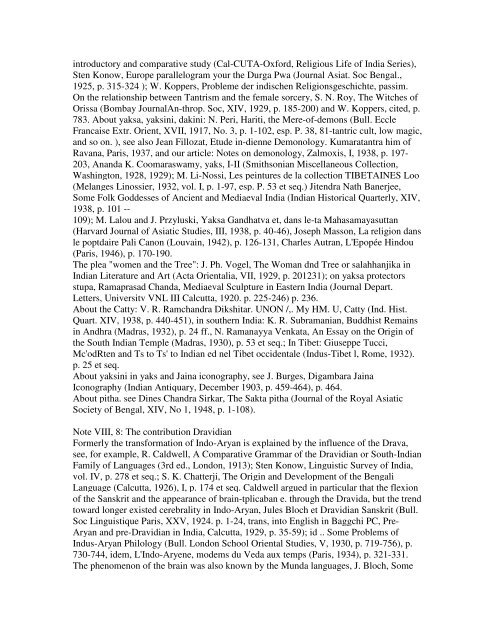Mircea Eliade YOGA IMMORTALITY AND ... - Brihaspati.net
Mircea Eliade YOGA IMMORTALITY AND ... - Brihaspati.net
Mircea Eliade YOGA IMMORTALITY AND ... - Brihaspati.net
Create successful ePaper yourself
Turn your PDF publications into a flip-book with our unique Google optimized e-Paper software.
introductory and comparative study (Cal-CUTA-Oxford, Religious Life of India Series),<br />
Sten Konow, Europe parallelogram your the Durga Pwa (Journal Asiat. Soc Bengal.,<br />
1925, p. 315-324 ); W. Koppers, Probleme der indischen Religionsgeschichte, passim.<br />
On the relationship between Tantrism and the female sorcery, S. N. Roy, The Witches of<br />
Orissa (Bombay JournalAn-throp. Soc, XIV, 1929, p. 185-200) and W. Koppers, cited, p.<br />
783. About yaksa, yaksini, dakini: N. Peri, Hariti, the Mere-of-demons (Bull. Eccle<br />
Francaise Extr. Orient, XVII, 1917, No. 3, p. 1-102, esp. P. 38, 81-tantric cult, low magic,<br />
and so on. ), see also Jean Fillozat, Etude in-dienne Demonology. Kumaratantra him of<br />
Ravana, Paris, 1937, and our article: Notes on demonology, Zalmoxis, I, 1938, p. 197-<br />
203, Ananda K. Coomaraswamy, yaks, I-II (Smithsonian Miscellaneous Collection,<br />
Washington, 1928, 1929); M. Li-Nossi, Les peintures de la collection TIBETAINES Loo<br />
(Melanges Linossier, 1932, vol. I, p. 1-97, esp. P. 53 et seq.) Jitendra Nath Banerjee,<br />
Some Folk Goddesses of Ancient and Mediaeval India (Indian Historical Quarterly, XIV,<br />
1938, p. 101 --<br />
109); M. Lalou and J. Przyluski, Yaksa Gandhatva et, dans le-ta Mahasamayasuttan<br />
(Harvard Journal of Asiatic Studies, III, 1938, p. 40-46), Joseph Masson, La religion dans<br />
le poptdaire Pali Canon (Louvain, 1942), p. 126-131, Charles Autran, L'Epopée Hindou<br />
(Paris, 1946), p. 170-190.<br />
The plea "women and the Tree": J. Ph. Vogel, The Woman dnd Tree or salahhanjika in<br />
Indian Literature and Art (Acta Orientalia, VII, 1929, p. 201231); on yaksa protectors<br />
stupa, Ramaprasad Chanda, Mediaeval Sculpture in Eastern India (Journal Depart.<br />
Letters, Universitv VNL III Calcutta, 1920. p. 225-246) p. 236.<br />
About the Catty: V. R. Ramchandra Dikshitar. UNON /,. My HM. U, Catty (Ind. Hist.<br />
Quart. XIV, 1938, p. 440-451), in southern India: K. R. Subramanian, Buddhist Remains<br />
in Andhra (Madras, 1932), p. 24 ff., N. Ramanayya Venkata, An Essay on the Origin of<br />
the South Indian Temple (Madras, 1930), p. 53 et seq.; In Tibet: Giuseppe Tucci,<br />
Mc'odRten and Ts to Ts' to Indian ed nel Tibet occidentale (Indus-Tibet l, Rome, 1932).<br />
p. 25 et seq.<br />
About yaksini in yaks and Jaina iconography, see J. Burges, Digambara Jaina<br />
Iconography (Indian Antiquary, December 1903, p. 459-464), p. 464.<br />
About pitha. see Dines Chandra Sirkar, The Sakta pitha (Journal of the Royal Asiatic<br />
Society of Bengal, XIV, No 1, 1948, p. 1-108).<br />
Note VIII, 8: The contribution Dravidian<br />
Formerly the transformation of Indo-Aryan is explained by the influence of the Drava,<br />
see, for example, R. Caldwell, A Comparative Grammar of the Dravidian or South-Indian<br />
Family of Languages (3rd ed., London, 1913); Sten Konow, Linguistic Survey of India,<br />
vol. IV, p. 278 et seq.; S. K. Chatterji, The Origin and Development of the Bengali<br />
Language (Calcutta, 1926), I, p. 174 et seq. Caldwell argued in particular that the flexion<br />
of the Sanskrit and the appearance of brain-tplicaban e. through the Dravida, but the trend<br />
toward longer existed cerebrality in Indo-Aryan, Jules Bloch et Dravidian Sanskrit (Bull.<br />
Soc Linguistique Paris, XXV, 1924. p. 1-24, trans, into English in Baggchi PC, Pre-<br />
Aryan and pre-Dravidian in India, Calcutta, 1929, p. 35-59); id .. Some Problems of<br />
Indus-Aryan Philology (Bull. London School Oriental Studies, V, 1930, p. 719-756), p.<br />
730-744, idem, L'Indo-Aryene, modems du Veda aux temps (Paris, 1934), p. 321-331.<br />
The phenomenon of the brain was also known by the Munda languages, J. Bloch, Some







